Table of Contents
Video tutorial
Formula (calculated) columns in wpDataTables
From version 5.7, the calculation functions can also be used in Formula Columns.
If your dataset used for wpDataTable creation is not comprehensive – if for example, it shows only the price without VAT tax, or you need a column showing a result of calculation based on other columns’ cell values, you can use the formula (calculated) columns.
See this table: “Tax” and “Difference” columns do not exist in the dataset. They are calculated “on the fly” using the formula columns feature.
| Region | Type | Net cost | Catalog cost | Tax | Difference |
|---|---|---|---|---|---|
| Zuid Holland | Terraced house | 49,188 | 54,107 | 9,739.26 | 14,658.26 |
| Rivers | Apartment | 11,139 | 12,253 | 2,205.54 | 3,319.54 |
| Västra Götalands län | Tyneside flat | 35,226 | 38,749 | 6,974.82 | 10,497.82 |
| Connacht | Flat | 24,206 | 26,627 | 4,792.86 | 7,213.86 |
| Wielkopolskie | Apartment | 89,710 | 98,681 | 17,762.58 | 26,733.58 |
| Wielkopolskie | Apartment | 87,461 | 96,207 | 17,317.26 | 26,063.26 |
| Jönköpings län | Flat | 13,704 | 15,074 | 2,713.32 | 4,083.32 |
| Alajuela | Apartment | 76,984 | 84,682 | 15,242.76 | 22,940.76 |
| Utrecht | Terraced house | 41,625 | 45,788 | 8,241.84 | 12,404.84 |
| Western Australia | Garden flat | 68,300 | 75,130 | 13,523.40 | 20,353.40 |
| Dr | Garden flat | 81,117 | 89,229 | 16,061.22 | 24,173.22 |
| Leinster | Terraced house | 40,652 | 44,717 | 8,049.06 | 12,114.06 |
| Noord Brabant | Terraced house | 85,792 | 94,371 | 16,986.78 | 25,565.78 |
| SI | Flat | 6,539 | 7,193 | 1,294.74 | 1,948.74 |
| Wie | Tyneside flat | 23,464 | 25,810 | 4,645.80 | 6,991.80 |
| MH | Apartment | 36,653 | 40,318 | 7,257.24 | 10,922.24 |
| Roxburghshire | Tyneside flat | 75,914 | 83,505 | 15,030.90 | 22,621.90 |
| Kay | Flat | 15,222 | 16,744 | 3,013.92 | 4,535.92 |
| BC | Garden flat | 99,087 | 108,996 | 19,619.28 | 29,528.28 |
| AB | Tyneside flat | 93,474 | 102,821 | 18,507.78 | 27,854.78 |
| Saarland | Apartment | 19,910 | 21,901 | 3,942.18 | 5,933.18 |
| São Paulo | Apartment | 9,173 | 10,090 | 1,816.20 | 2,733.20 |
| N. | Apartment | 15,202 | 16,722 | 3,009.96 | 4,529.96 |
| Östergötlands län | Apartment | 30,186 | 33,205 | 5,976.90 | 8,995.90 |
| Uttar Pradesh | Tyneside flat | 23,237 | 25,561 | 4,600.98 | 6,924.98 |
| Oklahoma | Garden flat | 23,034 | 25,337 | 4,560.66 | 6,863.66 |
| Languedoc-Roussillon | Apartment | 12,321 | 13,553 | 2,439.54 | 3,671.54 |
| AB | Tyneside flat | 57,508 | 63,259 | 11,386.62 | 17,137.62 |
| C | Flat | 3,071 | 3,378 | 608.04 | 915.04 |
| Hamburg | Apartment | 47,860 | 52,646 | 9,476.28 | 14,262.28 |
| UP | Garden flat | 4,241 | 4,665 | 839.70 | 1,263.70 |
| WP | Tyneside flat | 99,853 | 109,838 | 19,770.84 | 29,755.84 |
| Andalucía | Tyneside flat | 83,485 | 91,834 | 16,530.12 | 24,879.12 |
| Centre | Flat | 87,639 | 96,403 | 17,352.54 | 26,116.54 |
| VA | Garden flat | 41,906 | 46,097 | 8,297.46 | 12,488.46 |
| NI | Terraced house | 42,484 | 46,732 | 8,411.76 | 12,659.76 |
| Madrid | Garden flat | 42,273 | 46,500 | 8,370.00 | 12,597.00 |
| NSW | Terraced house | 38,732 | 42,605 | 7,668.90 | 11,541.90 |
| San José | Flat | 33,341 | 36,675 | 6,601.50 | 9,935.50 |
| NSW | Tyneside flat | 53,757 | 59,133 | 10,643.94 | 16,019.94 |
| Guanacaste | Garden flat | 39,567 | 43,524 | 7,834.32 | 11,791.32 |
| Zl | Apartment | 22,408 | 24,649 | 4,436.82 | 6,677.82 |
| Hampshire | Flat | 30,921 | 34,013 | 6,122.34 | 9,214.34 |
| BE | Flat | 25,294 | 27,823 | 5,008.14 | 7,537.14 |
| Paraná | Terraced house | 19,868 | 21,855 | 3,933.90 | 5,920.90 |
| Niger | Terraced house | 53,943 | 59,337 | 10,680.66 | 16,074.66 |
| JH | Tyneside flat | 11,476 | 12,624 | 2,272.32 | 3,420.32 |
| Maharastra | Flat | 57,554 | 63,309 | 11,395.62 | 17,150.62 |
| South Australia | Tyneside flat | 52,292 | 57,521 | 10,353.78 | 15,582.78 |
| CA | Terraced house | 77,019 | 84,721 | 15,249.78 | 22,951.78 |
| Hamburg | Terraced house | 78,409 | 86,250 | 15,525.00 | 23,366.00 |
| Vienna | Terraced house | 84,402 | 92,842 | 16,711.56 | 25,151.56 |
| Ohio | Flat | 15,223 | 16,745 | 3,014.10 | 4,536.10 |
| E | Garden flat | 84,734 | 93,207 | 16,777.26 | 25,250.26 |
| Vlaams-Brabant | Garden flat | 24,510 | 26,961 | 4,852.98 | 7,303.98 |
| SJ | Terraced house | 25,111 | 27,622 | 4,971.96 | 7,482.96 |
| OY | Garden flat | 27,279 | 30,007 | 5,401.26 | 8,129.26 |
| C | Garden flat | 49,670 | 54,637 | 9,834.66 | 14,801.66 |
| North Island | Flat | 78,208 | 86,029 | 15,485.22 | 23,306.22 |
| Wie | Garden flat | 8,764 | 9,640 | 1,735.20 | 2,611.20 |
| Noord Brabant | Flat | 53,045 | 58,350 | 10,503.00 | 15,808.00 |
| Zl | Tyneside flat | 24,410 | 26,851 | 4,833.18 | 7,274.18 |
| Ulster | Terraced house | 44,111 | 48,522 | 8,733.96 | 13,144.96 |
| AB | Tyneside flat | 28,326 | 31,159 | 5,608.62 | 8,441.62 |
| Berwickshire | Garden flat | 55,491 | 61,040 | 10,987.20 | 16,536.20 |
| IM | Tyneside flat | 99,104 | 109,014 | 19,622.52 | 29,532.52 |
| MH | Garden flat | 25,850 | 28,435 | 5,118.30 | 7,703.30 |
| Kahramanmaraş | Garden flat | 71,781 | 78,959 | 14,212.62 | 21,390.62 |
| BU | Garden flat | 91,154 | 100,269 | 18,048.42 | 27,163.42 |
| BA | Garden flat | 53,861 | 59,247 | 10,664.46 | 16,050.46 |
| Hamburg | Flat | 13,646 | 15,011 | 2,701.98 | 4,066.98 |
| ST | Terraced house | 73,394 | 80,733 | 14,531.94 | 21,870.94 |
| DS | Terraced house | 80,418 | 88,460 | 15,922.80 | 23,964.80 |
| PA | Flat | 53,226 | 58,549 | 10,538.82 | 15,861.82 |
| Kujawsko-pomorskie | Garden flat | 70,998 | 78,098 | 14,057.64 | 21,157.64 |
| BC | Flat | 47,774 | 52,551 | 9,459.18 | 14,236.18 |
| Vermont | Flat | 59,454 | 65,399 | 11,771.82 | 17,716.82 |
| BE | Terraced house | 21,850 | 24,035 | 4,326.30 | 6,511.30 |
| LU | Apartment | 74,885 | 82,374 | 14,827.32 | 22,316.32 |
| South Island | Terraced house | 89,110 | 98,021 | 17,643.78 | 26,554.78 |
| OP | Apartment | 69,448 | 76,393 | 13,750.74 | 20,695.74 |
| BA | Terraced house | 67,929 | 74,722 | 13,449.96 | 20,242.96 |
| Ontario | Garden flat | 48,449 | 53,294 | 9,592.92 | 14,437.92 |
| New South Wales | Tyneside flat | 90,339 | 99,373 | 17,887.14 | 26,921.14 |
| O'Higgins | Garden flat | 57,528 | 63,281 | 11,390.58 | 17,143.58 |
| AN | Terraced house | 38,229 | 42,052 | 7,569.36 | 11,392.36 |
| Guanacaste | Garden flat | 66,160 | 72,776 | 13,099.68 | 19,715.68 |
| IN | Garden flat | 80,812 | 88,893 | 16,000.74 | 24,081.74 |
| Jigawa | Terraced house | 47,679 | 52,447 | 9,440.46 | 14,208.46 |
| MB | Flat | 32,147 | 35,362 | 6,365.16 | 9,580.16 |
| Comunitat Valenciana | Terraced house | 45,468 | 50,015 | 9,002.70 | 13,549.70 |
| New South Wales | Garden flat | 36,044 | 39,648 | 7,136.64 | 10,740.64 |
| C | Terraced house | 24,426 | 26,869 | 4,836.42 | 7,279.42 |
| MI | Flat | 81,871 | 90,058 | 16,210.44 | 24,397.44 |
| South Island | Flat | 22,516 | 24,768 | 4,458.24 | 6,710.24 |
| PO | Flat | 56,513 | 62,164 | 11,189.52 | 16,840.52 |
| North Rhine-Westphalia | Apartment | 16,617 | 18,279 | 3,290.22 | 4,952.22 |
| South Australia | Tyneside flat | 33,039 | 36,343 | 6,541.74 | 9,845.74 |
| Cartago | Garden flat | 8,731 | 9,604 | 1,728.72 | 2,601.72 |
| CA | Tyneside flat | 92,651 | 101,916 | 18,344.88 | 27,609.88 |
| Region | Type | Net cost | Catalog cost |
Please note that formulas in wpDataTables are NOT THE SAME as formulas in Excel!
Creating a formula column
Any table can have a formula column. To add one, you can click the “Add a formula column” button:

Formula constructor
After you click the “Add formula a column” button, you will see a popup formula constructor. It has a fixed name ‘formula_1’, ‘formula_2’, etc. – depending on the amount of formulas that you added.
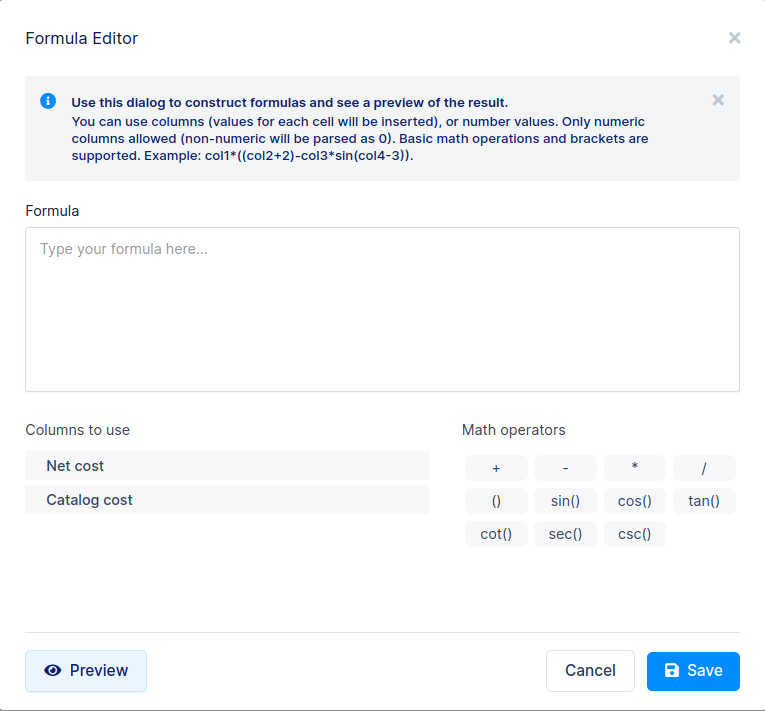
The formula constructor popup has several main elements:
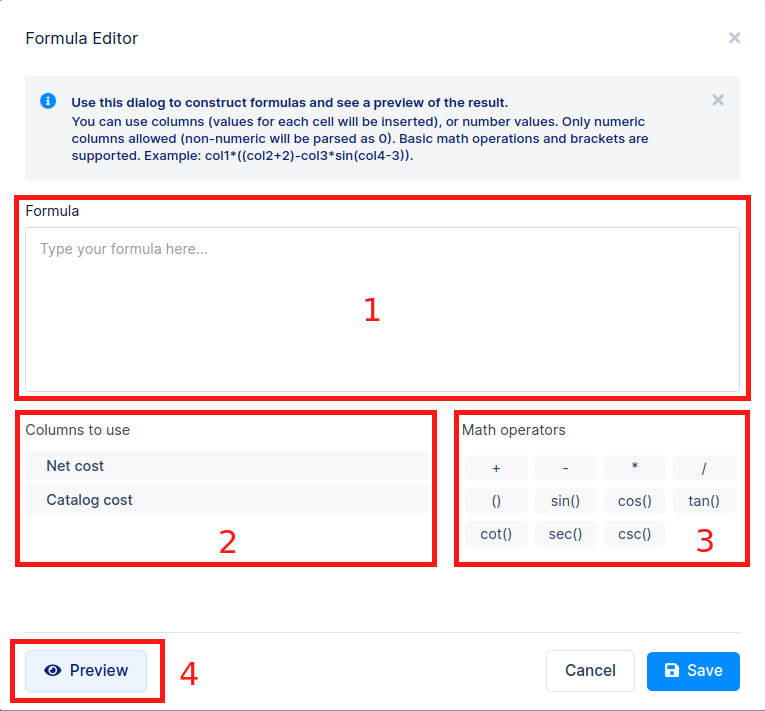
- Formula. The created formula itself.
- Columns that can be used in the formula. Please note that only numeric (float and integer columns) can be used in formula columns.
- Supported operators. Formulas in wpDataTables support all arithmetic operators, brackets to define the calculation order, and trigonometric operators.
- Preview button and preview section. Once you prepare the formula, you can click this button to see the result for the first 5 rows of your table to verify the calculation is correct.
Additionally, there is an explanation text on the top.
You can use columns (values for each cell will be inserted), or number values. Only numeric columns are allowed (non-numeric will be parsed as 0). Basic math operations and brackets are supported. Example: col1*((col2+2)-col3*sin(col4-3)).
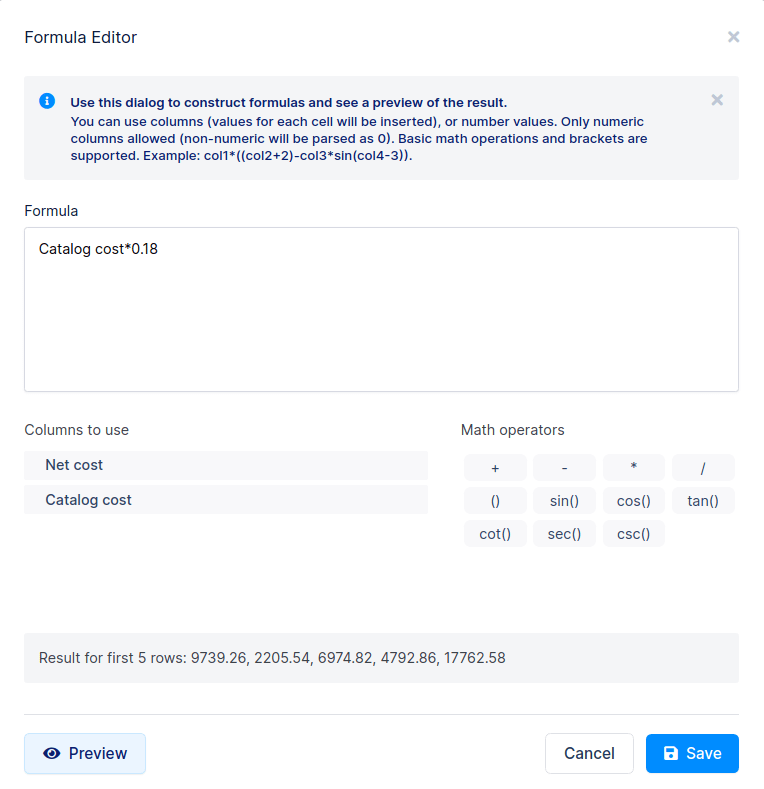
To calculate the “Tax” column in the above example, we can simply use the catalog cost column value, multiply it by some number, and click “Save“.
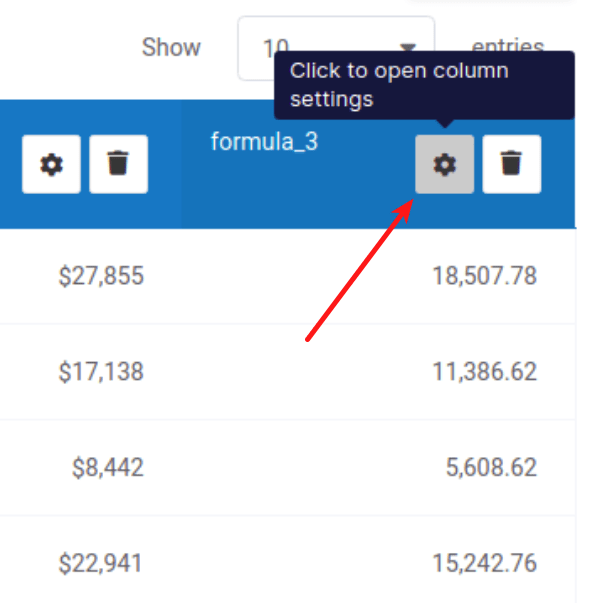
Now let’s change the displayed header of the formula column. To do that, click the button for column settings.
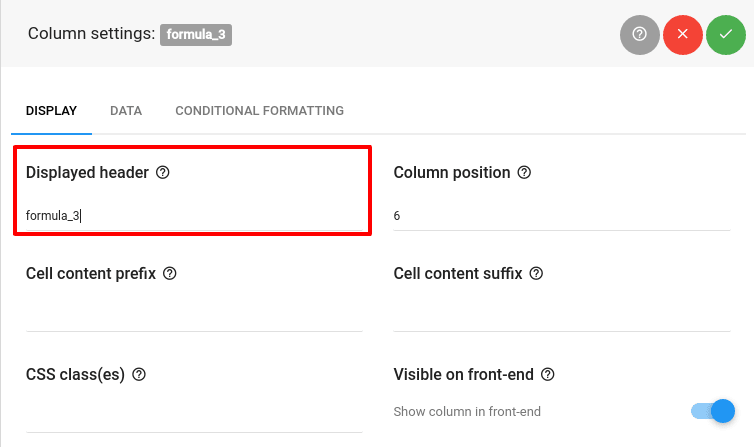
Enter the new value in the “Displayed header” input in the first tab column setting and click apply.
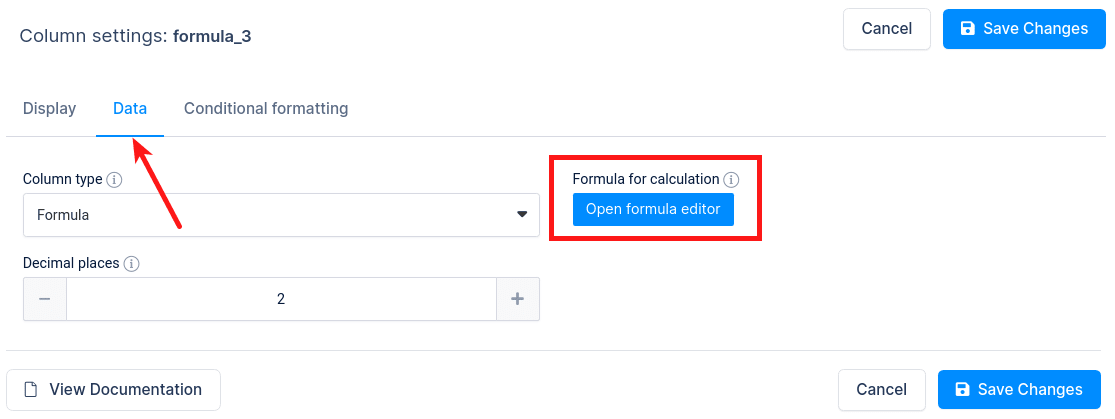
If you want to change the formula for a calculation you can go to the “Data” tab and click on the “Open Formula Editor” button.
After you click on THE “Open Formula Editor” button, the formula constructor popup will appear. You can use it to adjust the formula that is used for calculation.
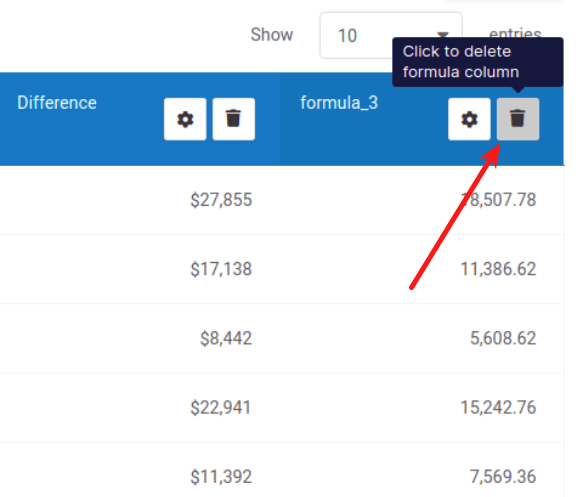
Formula columns can be easily deleted by clicking the “Delete” button in the column header area in the live table preview.
There are several limitations when using formula columns in wpDataTables:
- One formula column cannot be used in another. This limitation can be avoided by using nested calculations.
- In tables with server-side processing formulas, columns cannot be used for grouping, filtering, and sorting. Basically, formulas are calculated only for the rows that are immediately visible; Therefore, it’s not possible to “know” the values for currently invisible rows. Please note that this also applies to the “Manual” tables, as they also use server-side processing by default. Also, of course, it is not possible to edit the cells generated by formulas in the editable tables.
- A formula column can not be used as the default sorting column (sort table by this column on load).
Read more
Click here to see this table in our sandbox site or here to play around with back-end configuration.
- Creating editable tables and filling the table data manually
- Creating non-editable tables from Excel files
- Creating non-editable tables from Google Spreadsheets
- String columns
- Integer columns
- Float columns
- Date columns
- DateTime columns
- Time columns
- Image columns
- URL link columns
- E-mail link columns
- Currency/price columns
- Coloring and styling columns
- Hiding columns
